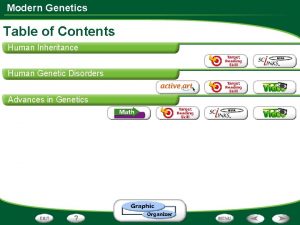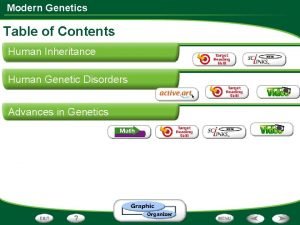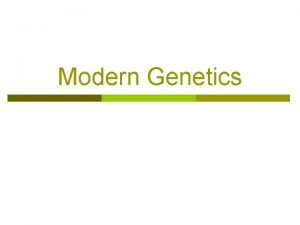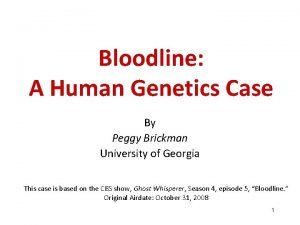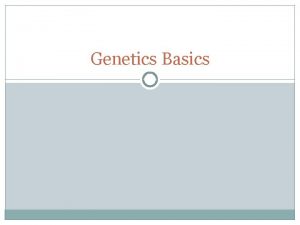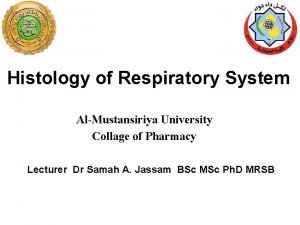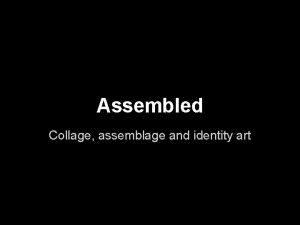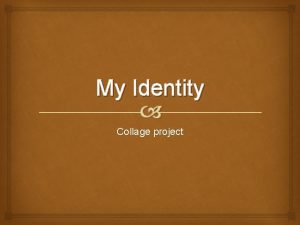An introduction to Human Genetics AlMustansiriya University Collage
















- Slides: 16

An introduction to Human Genetics Al-Mustansiriya University Collage of Pharmacy Lecturer Dr Samah A. Jassam BSc MSc Ph. D MRSB

What is the secret behind the transmission of hereditary characteristics from generation to generation? https: //cytogenetics-sites. uchicago. edu/

Basic Concepts of Genetics/ Mendel`s laws Mendel's observations led to two laws, regarding the transmission of hereditary characteristics from generation to generation. First law: Principle of Segregation: Two alleles segregate randomly from each other during the formation of gametes. It means, that each gene has two copies (alleles), and each parent will give one copy to a child. Parents AA aa Parental Gametes A A a a Image obtained from https: //www. google. iq/search? q=Gregor+Mendel F 1 generation AA Aa aa

Basic Concepts of Genetics/ Mendel`s laws Second law: Principle of Independent Assortment: Two genes will assort independently of one another in gamete production Parental Gametes Important teams to know: Alleles: are different versions of the same gene. Homozygous: refers to an individual with two identical alleles. Heterozygous: refers to an individual with two different alleles. Genotype: it refers to the specific allelic composition of an individual. Phenotype refers to the outward appearance of an individual. Parents Aa Bb AB Ab a. B ab

The genetic material: Genome • Genome as a term was suggested in 1920 by Hans Winkler, professor of biology (botany) at the University of Hamburg. Genome word is a blend of the words gene and chromosome. • The genome can be defined as the genetic material of an organism. It consists of DNA (or RNA in RNA viruses). The genome includes both the genes, (the coding regions), the noncoding DNA and the genomes of the mitochondria and chloroplasts.

Cytogenetics: the study of chromosomes • Cytogenetics is the study of chromosomes and their role in heredity. Cytogenetics focuses on studying structure, composition of chromosomes as well as, diagnosis of chromosomal abnormalities associated with diseases. • A karyotype refers to the number and appearance of chromosomes in the nucleus of a eukaryotic cell. It is also refers to the complete set of chromosomes in a species. • Among the members of a species, the number of chromosomes is uniform. • A normal human karyotype contains 22 pairs of autosomes and one pair of sex chromosomes. https: //cytogenetics-sites. uchicago. edu/

What is chromosome? Chromosome is a thread-like structures, it is consisted of DNA molecule packed tightly and coiled around a specific proteins called histones. Chromosomes are located in the nucleus of eukaryotic cells. DNA Double helix DNA & Histones chromosome

The structure of the chromosome • Chromatids are two identical parts of each chromosomes. • These chromatids are held together at a point named the centromere, which can be located at any point along the length of the chromosome. • Telomere is a region of repetitive nucleotide sequences. Telomere is located at each end of a chromosome, it protects the end of the chromosome from deterioration or from fusion with neighbouring chromosomes Chromatid P-arm(short) Centromere q-arm(long) Telomere

Chromosomal abnormalities • Almost every cell in our body contains 23 pairs of chromosomes, for a total of 46 chromosomes. • 22 pairs are called autosomes and 1 pair of sex chromosomes, XX in female and XY in male in each cell. • Chromosomal abnormalities can be categorised as: 1 - Numerical abnormalities refer to a missing or existing of a whole chromosome to the normal pair. 2 - Structural abnormalities occur when part of an individual chromosome is missing, extra, switched to another chromosome, or turned upside down.

How chromosomal abnormalities may occur? • Chromosomal abnormality may occur accidentally during: 1 - The formation of the egg or the sperm. 2 - The early developmental stages of the foetus. 3 - Certain environmental factors may play a role in the occurrence of genetic errors. http: //www. openaccessjournals. siftdesk. org/articles/full-text/Micronuclei-and-chromosome. html

Causes of chromosomal abnormalities 1) Some medicines 2) Street drugs 3) Alcohol 4) Tobacco 5) Toxic chemicals 6) Some viruses and bacteria 7) Some kinds of radiation 8) Certain health conditions, such as uncontrolled diabetes

The deoxyribonucleic acid (DNA) • DNA is the hereditary material in humans and almost all other organisms. • Nearly every cell in the body has the same DNA. • Most DNA is located in the The structure of DNA cell nucleus (where it is called nuclear DNA), but a small amount of DNA can also be found in the mitochondria (where it mitochondrial mt. DNA). is DNA called or Image is obtained from: https: //www. thinglink. com/scene

The ribonucleic acid (RNA) RNA is a polymeric molecule essential in various biological roles in: • coding, • decoding, • regulation, • and expression of genes. The types of RNA Image is obtained from: https: //www. thinglink. com/scene 1. messenger RNA (m. RNA) to convey genetic information 2. transfer RNA (t. RNA) molecules to deliver amino acids to the ribosome 3. ribosomal RNA (r. RNA) links amino acids together to form proteins

The main differences between DNA and RNA Difference DNA Definition It contains the genetic instructions used in the development and functioning of all modern living organisms. RNA It contains the genetic information that transcripted from DNA to RNA Function Medium of long-term, stable storage and transmission of genetic information Transfers genetic code needed for the creation of proteins from the nucleus to the ribosome. Structure Double-stranded Single-stranded. Base Pairing Adenine links to thymine Adenine links to uracil (A(A-T) and cytosine links to U) and cytosine links to guanine (C-G).

The main differences between DNA and RNA Difference DNA Location DNA is found in the nucleus of a cell and in mitochondria RNA Is is found in the nucleus, cytoplasm, ribosome. Stability Less Stable in alkaline conditions. RNA is synthesized from DNA when needed DNA is protected in the RNA strands are continually made, broken down and nucleus, as it is tightly reused. RNA is more resistant packed. DNA can be damaged by exposure to to damage by Ultra-violet rays. ultra-violet rays Propagation DNA is self-replicating Unique Features

The Human Genome Project (HGP) Images obtained from http: //www. online-sciences. com/HGP • The Human Genome Project (HGP) is an international scientific research project aims to determine the sequence of DNA, to identify and to map all of the genes of the human genome from both a physical and a functional standpoint. • The International Human Genome Sequencing Consortium published the first draft of the human genome in 2001 with the sequence of the entire genome's three billion base pairs some 90 percent complete. • The full sequence was completed and published in April 2003, the number of human genes appeared to be ranged between 50, 000 genes and 140, 000 genes.
 Human inheritance modern genetics answer key
Human inheritance modern genetics answer key Modern genetics human inheritance answer key
Modern genetics human inheritance answer key Modern genetics human inheritance answer key
Modern genetics human inheritance answer key 14-3 human molecular genetics answer key
14-3 human molecular genetics answer key Introduction to genetic analysis tenth edition
Introduction to genetic analysis tenth edition Peggy brickman
Peggy brickman Heterozygous blood type a
Heterozygous blood type a Socialization through life course
Socialization through life course Physical change collage
Physical change collage We……to the collage yesterday. *
We……to the collage yesterday. * Metaphor collage
Metaphor collage Metaphor collage
Metaphor collage Cultural collage ideas
Cultural collage ideas Collage kings act 1
Collage kings act 1 Características de animales invertebrados
Características de animales invertebrados What is illustrative collage
What is illustrative collage Collage who am i
Collage who am i
